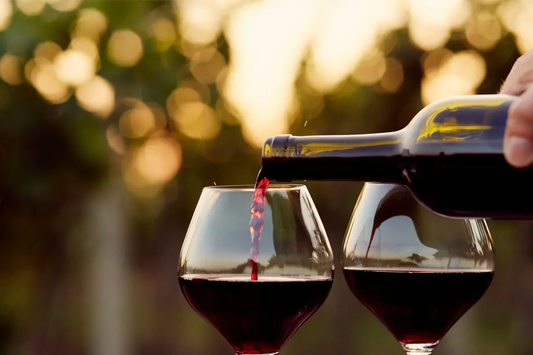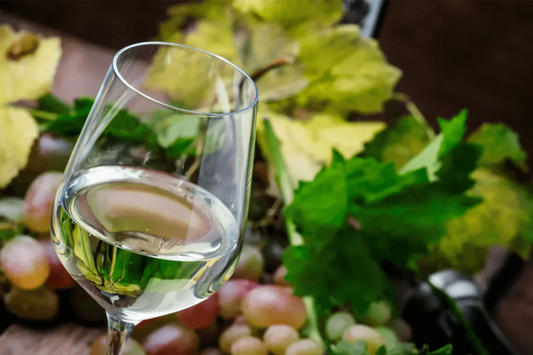
How to Read a Wine Label: A Beginner’s Guide to Choosing the Right Bottle
Deciphering a wine label is like cracking a code from a different language. With all the confusing terms, unfamiliar regions, and those fancy fonts, it can be tough to grasp what’s in the bottle. But the great news is that you don’t need to be a sommelier or a passionate wine lover to master the art of reading wine labels; it’s a simple skill that can empower you to pick out better wines, avoid clever marketing tricks, and discover bottles that you'll enjoy. In this guide, you’ll learn what to look for on a wine label, from grape variety and region to vintage and beyond, so you can shop confidently and feel smug knowing you've cracked the code.
Why Reading Wine Labels Matters
Wine labels are more than just marketing! They tell a story about where the wine comes from, its quality, and its unique character. Once you learn how to read them, you’ll:
- Spot better quality wine more easily
- Avoid overpaying for underwhelming bottles
- Match wine with your personal taste preferences
- Understand what’s inside before you uncork
The 6 Key Elements of a Wine Label
Here’s a quick overview: a wine label usually has six key details. These elements help answer the most important questions about the wine you're enjoying:
- Producer or brand (who made it)
- Region or country (where it’s from)
- Grape variety (what it’s made from)
- Vintage (when the grapes were harvested)
- Alcohol content (how strong it is)
- Special terms or certifications (how it was made)
Grasping these fundamentals gives you a strong base. From there, we can dive into how to decode them like a pro.
1. Wine Producer or Brand Name
When it comes to wine, the producer's name, whether a well-known brand or a small, family-run estate, often gives you your first hint about the wine’s origin and character. While casual wine drinkers might see this as a small detail, seasoned enthusiasts recognise that the producer's reputation often says a lot about the quality of what’s inside the bottle.
Some bottles feature prominent brand names, which can indicate consistency and scale. Others draw attention to the estate or château, especially in traditional European wines, where the winery’s name can overshadow the grape itself. Boutique producers often take personal pride in every step of the process, resulting in wines that reflect their unique style and philosophy.
If you come across terms like “Estate Bottled” or “Mis en Bouteille au Domaine,” consider it a positive sign. This typically means that the wine was grown, harvested, and bottled in the same spot, with a strong focus on quality at every stage.
2. Region or Country of Origin
When looking at a wine label, one of the first things to check is where the wine comes from. This detail is usually printed at the top or bottom of the front label, and it can indicate either the country or a more specific region. In many Old World wines, producers tend to focus on the wine region rather than just the country, especially if that region has a strong reputation for quality.
Knowing the region gives you valuable insights into the wine’s flavour profile, quality, and production standards. Generally, the more specific the location, the higher the chance that the wine is of better quality and often more expensive. Familiarising yourself with how different wine-producing countries label their bottles can help you understand what you're buying and steer clear of vague or generic claims.
French Labelling Terms
France has a set of regional classifications that indicate both quality and origin. These classifications are legally defined and strictly regulated.
- Vin de Pays (VdP): Entry-level wines from broad geographical areas with few production rules.
- Appellation d’Origine Contrôlée (AOC): High-quality wines from specific regions that follow strict regulations for grape variety, yield, and production method.
- Well-known AOCs include Champagne, Bordeaux, and Châteauneuf-du-Pape.
- Look for “Mis en Bouteille au Château” to indicate estate-bottled wine from the vineyard itself.
Spanish Labelling Terms
In Spain, wines are also categorised based on their geographic origin and quality standards. These levels make it easier to understand how closely each wine has been regulated:
- Vino de la Tierra (VdIT): Regional wines with basic production standards.
- Denominación de Origen (DO): Wines from recognised areas with moderate regulations on grapes and methods.
- Denominación de Origen Calificada (DOCa): Reserved for regions with a long-standing reputation for exceptional quality, such as Rioja and Priorat.
Italian Labelling Terms
Italy’s wine labels showcase a tiered system that’s rooted in both region and regulation. Understanding these terms can make it easier for you to assess quality in a snap:
- Indicazione Geografica Tipica (IGT): Wines with few restrictions, allowing for experimentation and broader blending.
- Denominazione di Origine Controllata (DOC): Wines from specific regions with controlled production methods.
- Denominazione di Origine Controllata e Garantita (DOCG): Italy’s highest classification, indicating strict standards and guaranteed quality. Famous DOCGs include Barolo, Brunello di Montalcino, and Barbera d’Asti.
3. Grape Variety (Varietal)
Most wine labels display the type of grape used, the varietal, on the front of the bottle. When you spot familiar names like Pinot Noir, Chardonnay, or Malbec, you immediately get an idea of the wine’s flavour, acidity, tannin level, and body.
If a grape isn’t mentioned, it usually means the wine is a blend or comes from an Old World region, where they expect you to be familiar with the grapes involved. In those situations, the appellation, like “Chianti” or “Bordeaux”, can provide a clue, as many regions have specific regulations about which grapes can be included in their wines.
For example, while French wines might not explicitly say “Chardonnay” or “Pinot Noir” on the label, you can expect to find those grapes in a white or red Burgundy. In contrast, New World wines, like those from California or Australia, usually have the grape varieties clearly labelled right on the front.
Even if a bottle claims to be a single varietal, depending on the region's regulations, it can still contain a small percentage of other grapes.
4. Vintage (Harvest Year)
The vintage is about the year when the grapes were harvested; you can usually find this information printed on the label. If you’re curious, sometimes you might need to check the neck of the bottle or flip it over to see it on the back.
A wine’s vintage can tell you about its quality and how it will age. Since weather plays a vital role in how grapes develop, even the same wine from different years can taste quite distinct. For instance, a hot, dry season might create rich, full-bodied wines, while a cooler year could yield lighter, higher-acid varieties.
In the world of premium wines, the vintage holds great importance. For example, Vintage Champagne or Vintage Port is crafted only during exceptional years, making a vintage label a lovely indicator of superior quality.
When it comes to our everyday wines, checking the vintage is a handy way to see how fresh the wine is. For instance, a Sauvignon Blanc or refreshing Rosé is usually at its best within a year or two after bottling. On the other hand, robust red wines tend to get even better with a few years of ageing, which is quite exciting!
It's also wise to be mindful of vague terms like “Reserve” on wine labels. While these terms have legal definitions and ageing requirements in certain regions, like Spain’s Reserva or Gran Reserva, they are often just marketing terms that don’t hold much weight.
5. Alcohol by Volume (ABV)
ABV indicates the alcohol content in the wine, providing helpful hints about its body, richness, and ripeness. You’ll usually see it presented as a percentage, which can vary based on factors like the type of grape, the climate, and the winemaking style.
- 11–12.5%: lighter, often crisp and acidic
- 13–14.5%: balanced, richer profile
- 15%+: bolder, fuller-bodied wines (may taste “hot” or jammy if not well balanced)
6. Certifications and Other Labelling Terms
Words like “organic,” “unfiltered,” and “old vines” frequently pop up on wine labels, conveying insights about production methods or special qualities. While some of these terms are regulated to ensure accuracy, others, like “Reserve” in many regions, might just be for marketing flair. Being aware of what these terms really mean can help you navigate the wine world more confidently and avoid any misunderstandings.
- Organic / Biodynamic: Grown without synthetic chemicals
- Cuvée: Often indicates a blend or special selection
- Old Vines: Typically over 50 years old, producing concentrated flavour
- Barrel-aged / Oak-aged: Adds richness, spice, and complexity
- Unfiltered / Unfined: May appeal to natural wine lovers or vegans
| The 6 Key Elements of a Wine Label | ||
|---|---|---|
| Element | What It Tells You | Common Examples |
| Producer / Brand Name | Who made the wine: Could be a brand, estate, or small producer | – Château / Domaine: French estate – Estate Bottled: Made and bottled at the vineyard |
| Region / Country | Where the grapes were grown: From broad country to a specific vineyard | – AOC / DOCG: Strict regional quality laws – Vin de France: Generic French wine |
| Grape Variety | What grapes were used: Single varietal or blend | – Chardonnay / Merlot: Grape type – Blend: A mix of two or more varietals |
| Vintage | The year the grapes were harvested | – NV (Non-Vintage): Blend of multiple years |
| Alcohol by Volume (ABV) | The wine’s alcohol content shows strength and body | – 12.5%–14.5% ABV: Typical range |
| Certifications / Terms | Special traits or production methods | – Organic: No synthetic chemicals – Old Vines: Older vines = concentrated flavour – Cuvée: Special blend |
Technical Terms on Wine Labels
Once you get a handle on the basics, you’ll spot other terms hinting at how the wine was crafted or what sets it apart. These technical phrases might seem minor, but they can uncover a wealth of information about the wine’s unique character and quality.
- Non-Vintage (NV): Indicates a wine blended from grapes harvested in different years. Common in sparkling wines, NV wines prioritise consistency over uniqueness.
- ABV (Alcohol by Volume): Shows the wine’s strength. Lower ABV (~11–12.5%) = lighter wine; higher ABV (14%+) = fuller body and bolder flavour.
- Cuvée: A blend of grapes, vintages, or barrels. Often used to label a winemaker’s special or premium selection.
- Old Vines: Refers to wines made from older grapevines (usually 30+ years), which tend to produce more concentrated and flavourful grapes.
- Barrel-Aged / Oaked: Means the wine was aged in oak barrels, adding flavours like vanilla, spice, or toast, depending on the type of oak used.
- Unfiltered / Unfined: These wines skip filtering or fining to retain natural texture or make the wine vegan-friendly. Expect a bit more cloudiness or sediment.
- Organic: Signals that the grapes were grown without synthetic chemicals. Regulations vary, but it’s often a sign of sustainable practices.
- Mis en Bouteille au Château: A French phrase meaning the wine was bottled at the estate, a good indicator of estate-grown and produced quality.
How to Quickly Judge Wine Quality from the Label
Short on time? Here's a fast and simple way to spot a better-quality wine just by reading the label:
- Specific region > general country: A label that says “Barolo DOCG” or “Burgundy AOC” usually means higher quality than one that just says “Wine of France”.
- Named producer or estate: Look for names like Château, Domaine, or Estate Bottled. These often mean more control and care in winemaking.
- Vintage is listed: A specific year (e.g. 2019) is better than no year. It tells you how old the wine is and whether it’s meant to age or be drunk now.
- Watch for quality cues: Terms like AOC, DOCG, Gran Reserva, or Old Vines often indicate tradition, ageing, and stricter rules, which equate to better wine.
- Skip the fluff: If the label is vague and full of marketing words like “Special Selection” but lacks real info, it’s probably not a standout bottle.
Why Canned Wine Makes Smart Wine Buying Easier
If trying to figure out wine labels feels a bit daunting, you’re definitely not alone. That’s why more wine enthusiasts opt for canned wine, a format that removes intimidation while keeping what counts: quality, transparency, and convenience.
Canned wines usually come with clear, simple labels that showcase the grape, region, and style. No confusing terms or decoding needed. Plus, they’re pre-portioned, making it easy to sample different varietals without the commitment of a full bottle.
Whether you're new to the wine scene or just looking for a hassle-free, high-quality choice, canned wine is a smart option. It’s great for casual sipping, outdoor gatherings, or just having excellent wine on hand without the fuss.
👉 Check out our handpicked selection of premium canned wines, crafted for great flavour and designed for real life.
Conclusion
Understanding how to read a wine label can make selecting the perfect bottle so much easier! By paying attention to key details like the region, grape, and vintage, you’ll be able to shop smarter and enjoy better wine every time you indulge.
FAQ
1. What should I look for first when reading a wine label?
You can start with the essentials: check out the producer name, region, grape variety, and vintage. These details highlight where the wine originates, what it’s crafted from, and when it was made, important hints for assessing its style and quality!
2. How can I tell if a wine is good by the label?
Check for:
- A specific, recognised region (e.g. Chianti Classico, Burgundy AOC)
- A named producer or estate
- A vintage year
- Quality terms like DOCG, AOC, or Old Vines
Generic phrases without these details may signal lower quality or mass production.



